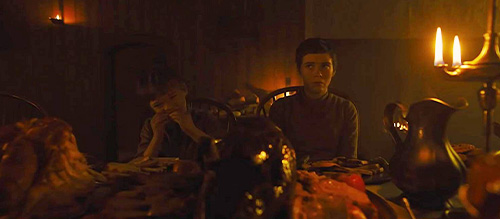Gretel and Hansel (2020) Review
Gretel & Hansel (2020)
Director: Oz Perkins
Screenwriter: Rob Hayes, Oz Perkins
Starring: Sophia Lillis, Sam Leakey, Alice Krige
Gretel & Hansel is a modern retelling of the classic folk story of an almost identical name. In case you don’t remember, the original tale follows a brother and sister who are abandoned by their parents. While wandering the woods, they happen upon a house made of candy. They start eating it, and then a witch catches them, inviting them into the house under the pretence of offering them a real meal. She then enslaves the siblings and begins fattening them up so that she can eat them herself. Her plan is foiled when Gretel uses reverse psychology to get the witch to crawl into an oven to make sure it’s hot enough for bread.
The traditional version of this particular faiytale is changed to incorporate more dark realism in Gretel & Hansel. Gretel, now the elder sibling, interviews for a job that is part housekeeper, part prostitution. Instead of a house made from food, the witch has a normal home, and the children are treated as guests who offered to help in exchange for a bed.
The witch takes Gretel under her wing, and shows her that she has a particular power within. This is first alluded to when she consults with some mushrooms on whether or not the siblings should eat them (yes, they are that variety of mushrooms). Gretel learns bits here and there about being witchy, but they spend more time talking about how Hansel is super annoying (he is), playing chess or drinking potions than they do learning witch stuff.
There’s a tale within the tale, about a girl with a pink hat. She was taken to an enchantress, who gave her great power in exchange for taking her sickness away. This introduces the “big idea” of the movie: nothing can be given without something else being taken. The movie doesn’t fully explore the idea, though. Not every gift comes with something sinister – a free couch on Craigslist may just require traveling to the seller’s house because they aren’t going to deliver a couch. If you gamble $5 and gain $20, something was given in exchange for more. The film would be strengthened by spending more time musing on this dichotomy it presents.
What the “give and take” idea really points to is the problems of sustainability and resource consumption in the modern world, though never in any direct sense. A witch using dead kids to maintain her lifestyle is similar to the way modern society condones terrible working conditions yet has shunked production of goods into countries that allow child labor. How much was sacrificed for us to have our phones, diamonds, and Nikes? Going down that route, the film really misses an opportunity to promote environmentalism, which could have added a layer of nuance to the witch. She was clearly into natural magic, and it would’ve been cool to watch her teach Gretel more of the ways of the Earth.
Cinematography is the real reason to watch this movie. The lenses create a strange view of the world, often shooting from a low angle and taking in a lot within the squared frame. It puts the viewer into a childlike perspective using large amounts of head space, which also allows for objects like the house to impose their will on the frame. One shot of Gretel shows a lit chandelier above her head like a crown – a shot that parallels the witch and a darkened chandelier later on. Triangles are used to show evil through the witch’s staff and house, trees that have fallen diagonally in the woods, and a pentagram, which literally symbolizes evil in mythology. Natural lighting is used beautifully throughout the film, but especially at night, where candles and windows create bold shadows against either orange or blue light. The best image in the movie shows a sinister red light in the woods as Gretel must decide whether or not to abandon her brother. It may be a bit strong and obvious, but the evil and darkness oozes right out of the screen.
This praise may have made the movie seem a lot better than it actually is because there’s not really enough meat for its 87 minute runtime. Parts feel repetitive or redundant because the setting of the witch’s house only allows for so much to happen. There may have been plenty of variety in the lighting, but there are too many scenes of two or three people sitting at a table – why not get outside to pick some roots, or do other witch stuff? And there’s one song in the soundtrack that sounds like it’s going to be Drake’s “0 to 100/The Catch Up”, but it isn’t.
If you enjoy a creepy atmosphere, there’s a chance none of those criticisms matter. At least it’s a coherent film, and has a distinct style to it. Gretel & Hansel wins the informal Best Horror Film of January competition, though we all know it wasn’t much of a contest to begin with. It may fade into obscurity, but the filmmakers deserve recognition of some sort for what they accomplished in this film.
14/24


